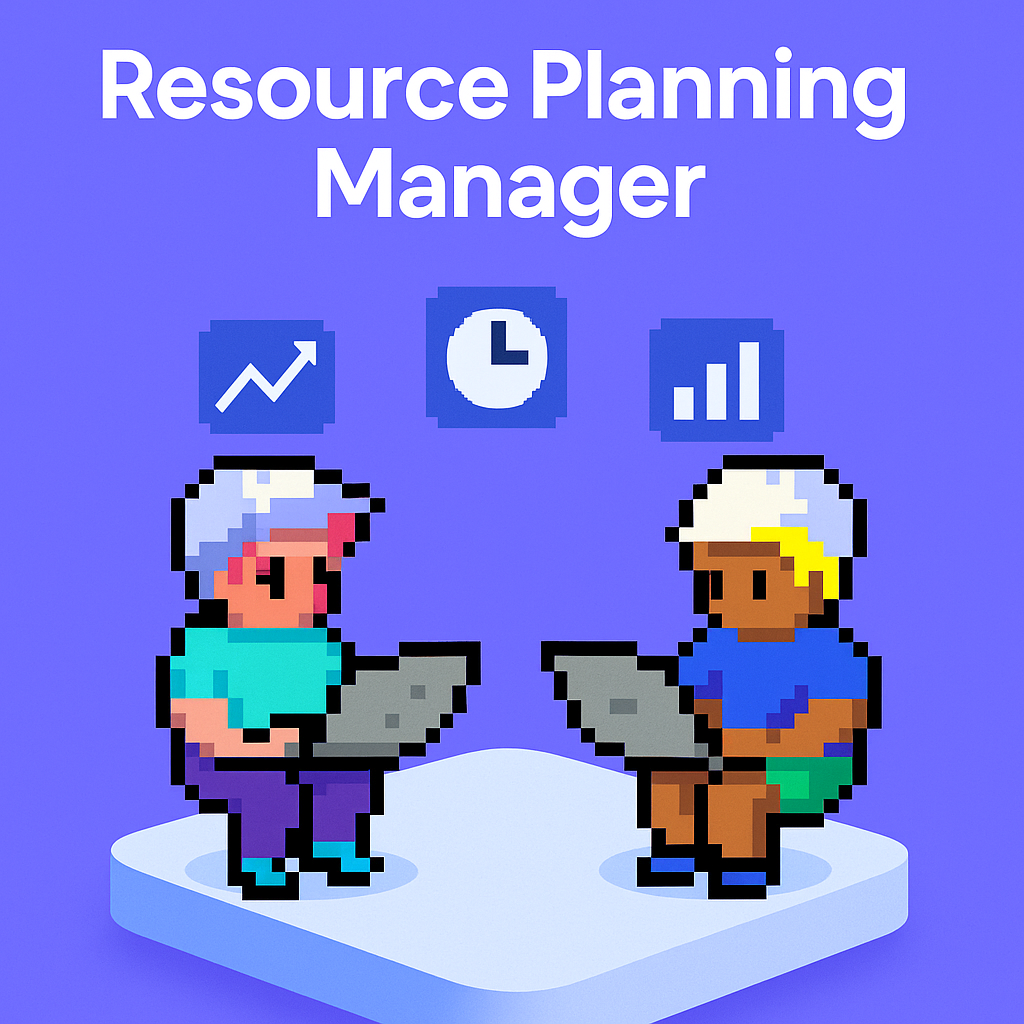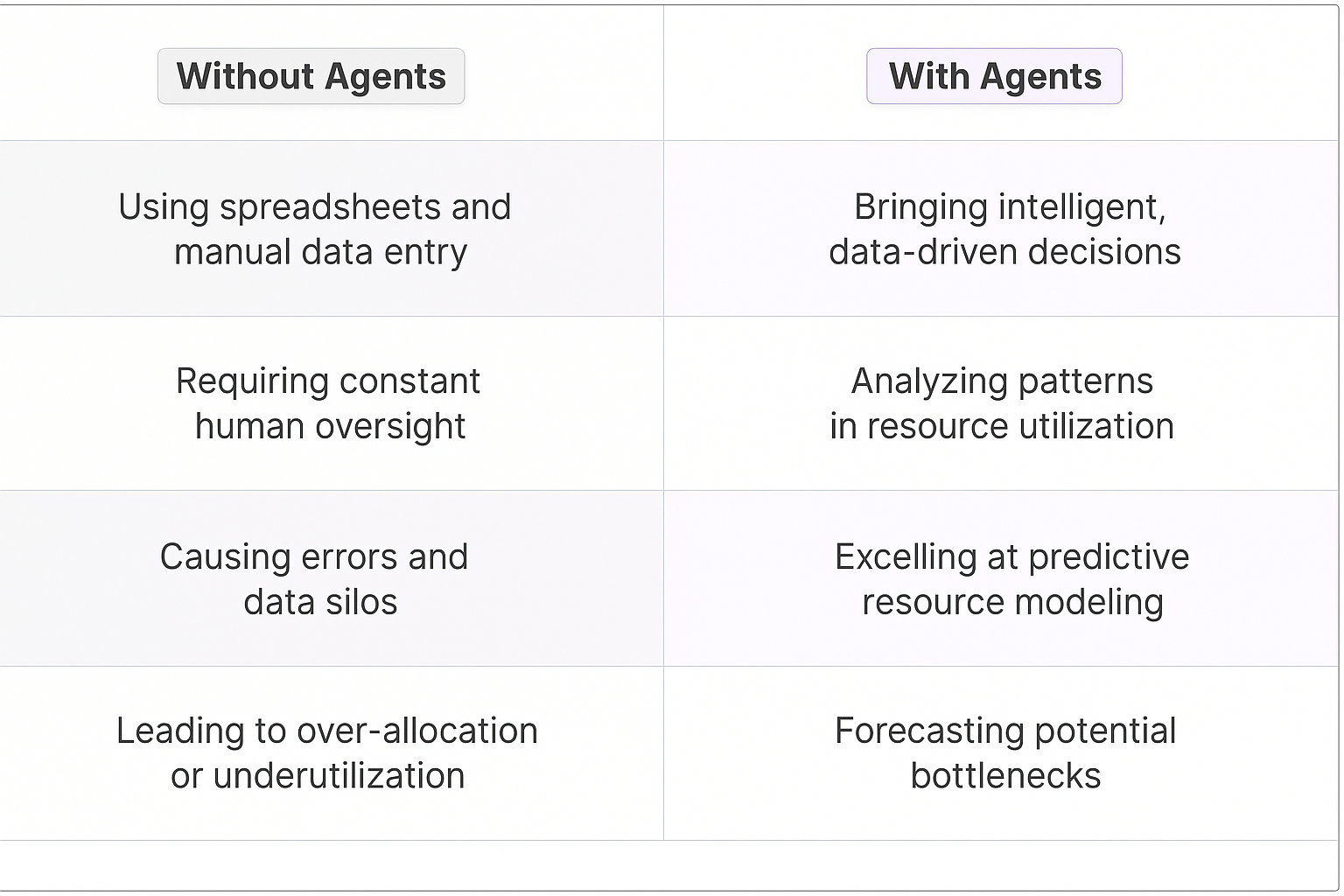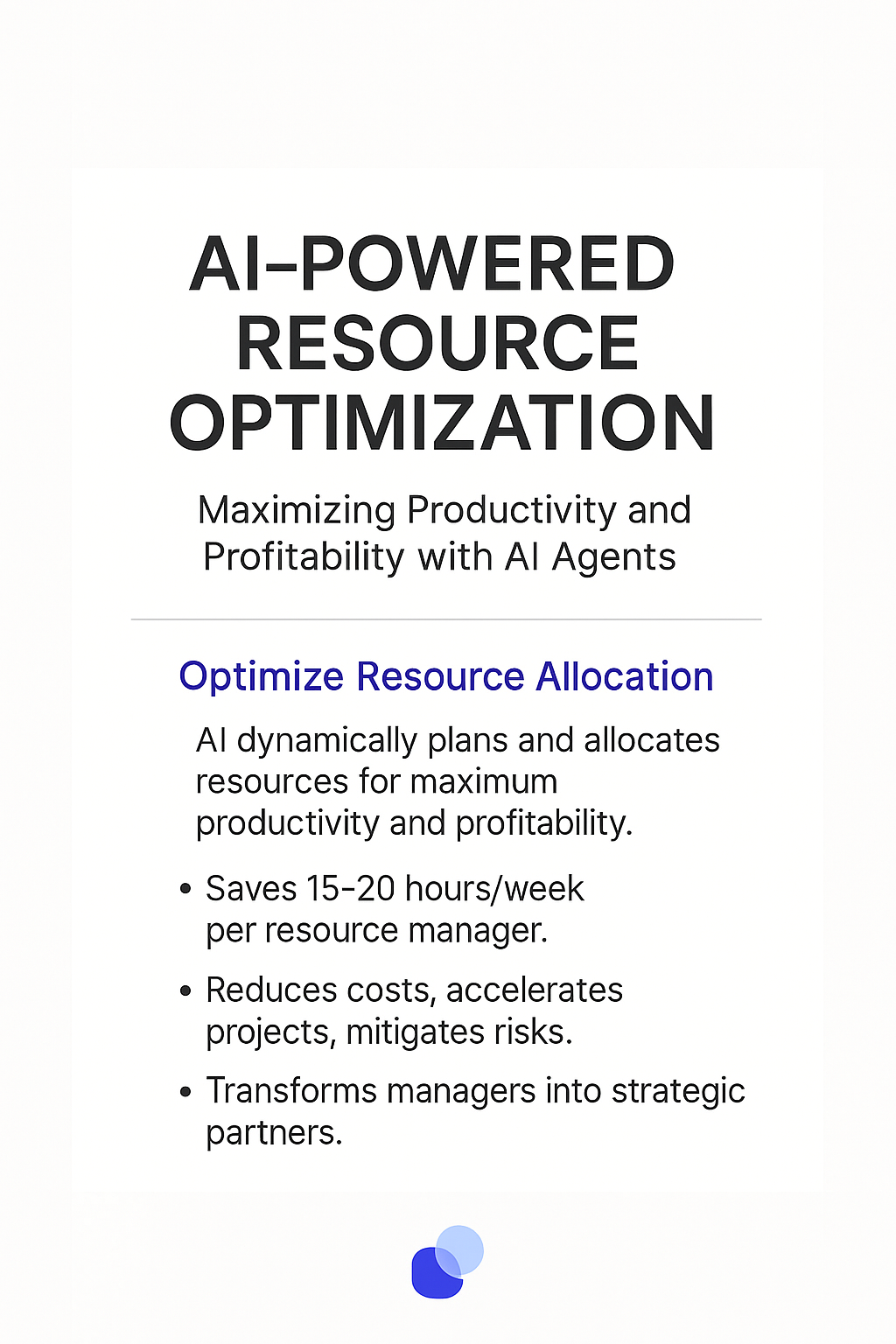
Resource Planning Manager represents a new breed of AI-powered tools that optimize how organizations allocate and manage their workforce. Unlike traditional resource management systems, it combines machine learning capabilities with deep understanding of team dynamics to make intelligent allocation decisions. The system continuously learns from past projects, team performance, and resource utilization patterns to improve its recommendations over time.

Resource planning traditionally relied on a mix of spreadsheets, manual data entry, and project management tools that required constant human oversight. Project managers spent countless hours juggling Excel files, updating Gantt charts, and manually calculating resource availability. The process was prone to errors, created data silos, and often led to either over-allocation or underutilization of team members.
The integration of AI agents into resource planning transforms how teams allocate and manage their resources. These digital teammates analyze historical project data, identify patterns in resource utilization, and make intelligent recommendations that human managers might miss.
AI agents excel at predictive resource modeling - they can forecast potential bottlenecks weeks before they occur by analyzing team capacity, skills matrices, and project timelines. When a new project lands, they instantly calculate the ripple effects across your entire resource pool.
The real game-changer is their ability to learn from past resource allocation decisions. They observe which team combinations delivered the best results and factor that into future recommendations. For example, if certain developers consistently deliver higher quality code when paired together, the AI will note this pattern and suggest similar pairings for upcoming projects.
These digital teammates also eliminate the cognitive load of constant resource reallocation. When team members call in sick or projects shift scope, the AI immediately recalculates the optimal resource distribution across all active projects. This dynamic reallocation happens in real-time, maintaining project momentum without requiring emergency planning meetings.
Perhaps most importantly, AI agents bring objectivity to resource planning. They make recommendations based on data rather than office politics or the loudest voice in the room. This leads to more equitable workload distribution and better utilization of your team's diverse skill sets.
Resource planning has traditionally been a complex dance of spreadsheets, gut feelings, and constant adjustment. Digital teammates are transforming this landscape by bringing data-driven precision to resource management decisions.
The most compelling aspect is how these AI agents handle the cognitive load of tracking multiple moving parts. They process vast amounts of project data, team availability, and skill matrices simultaneously - something human managers have always struggled with.
What's particularly fascinating is the emergence of predictive resource planning. AI agents don't just tell you about current resource conflicts; they anticipate potential issues weeks in advance. They're essentially giving project managers a time machine to prevent resource crunches before they materialize.
The real game-changer is the shift from reactive to proactive resource management. Instead of scrambling to find replacements when someone calls in sick, these digital teammates maintain dynamic backup plans, understanding which team members can step in based on their skills and current workload.
This isn't just about making resource planning easier - it's about fundamentally changing how organizations think about and deploy their talent. The most successful implementations I've seen treat AI agents as strategic partners in resource optimization rather than just scheduling tools.

Resource Planning Manager AI agents are transforming how organizations allocate and optimize their resources across multiple sectors. The integration of these digital teammates into resource planning creates a powerful shift in how teams handle complex resource allocation challenges. Let's dive into specific examples where these AI agents deliver meaningful impact.
What makes these use cases particularly compelling is how they address the core friction points in resource management - the constant juggling of shifting priorities, the need for real-time adjustments, and the challenge of maintaining optimal resource utilization. The AI agents serve as proactive partners, identifying patterns and making recommendations that human planners might miss in their day-to-day operations.
The most fascinating aspect is how these AI agents adapt their resource optimization strategies based on industry-specific constraints and requirements. They're not just following static rules - they're learning from each interaction and decision to build more nuanced and effective resource allocation models over time.
A mid-sized automotive parts manufacturer in Detroit faced a classic resource allocation problem - their production planning relied heavily on spreadsheets and weekly meetings. The leadership team spent 15-20 hours per week manually adjusting schedules, dealing with supply chain hiccups, and reallocating staff across production lines.
They implemented a Resource Planning Manager AI agent that transformed their approach. The agent continuously monitors real-time data from their ERP system, IoT sensors on the production floor, and workforce management software. When a critical supplier delayed a shipment of essential components, the agent quickly:
The most fascinating aspect wasn't just the time saved - it was how the AI agent learned the subtle constraints of their operation. It recognized that certain team members worked better together, specific machines required longer warm-up times after maintenance, and some product combinations were more efficient to run in sequence.
Within three months, the manufacturer reduced planning-related downtime by 47% and increased production line utilization by 23%. The human planners shifted from reactive scheduling to strategic improvement projects. One production manager noted, "The AI doesn't just move resources around - it understands the rhythm of our factory."
This case demonstrates how Resource Planning Manager AI agents can absorb the complexity of modern manufacturing operations while preserving the human elements that make each facility unique. The key isn't replacing human decision-making but augmenting it with computational power that can process thousands of variables simultaneously.
The integration with production planning systems enabled predictive maintenance scheduling and optimized resource allocation based on demand forecasts.
A large regional hospital network with 12 facilities across the Pacific Northwest struggled with the intricate dance of staffing their departments. Their manual scheduling process created bottlenecks, especially during flu seasons and unexpected patient surges. Nurses were burning out, and patient wait times kept creeping up.
The network deployed a Resource Planning Manager AI agent that dove deep into their staffing patterns. What makes this case fascinating is how the AI agent handled the multidimensional nature of healthcare staffing. It processed data from:
The AI agent's approach revealed subtle patterns human planners had missed. It discovered that certain nurse combinations in the ICU led to better patient outcomes. It identified optimal staff rotation patterns that reduced fatigue while maintaining continuity of care. When a mass casualty incident hit one of their facilities, the agent redistributed resources across the network within minutes.
The most compelling insight came from how the AI handled the human element. Instead of just optimizing for efficiency, it learned to balance staff preferences with patient needs. One nurse manager told me, "It feels like the system knows each nurse's strengths and creates schedules that play to those strengths."
After six months, the network saw a 31% reduction in overtime costs, a 28% improvement in staff satisfaction scores, and most importantly, a 15% decrease in patient wait times. The scheduling team now focuses on mentoring new staff and improving care protocols instead of juggling spreadsheets.
This transformation shows how AI agents can master the complexity of healthcare operations while preserving the human-centric nature of patient care. The key learning? When AI handles the computational heavy lifting, healthcare professionals can focus on what they do best - caring for patients.

Resource planning AI agents require deep integration with existing enterprise systems - from HR databases to project management tools. The data architecture needs to handle real-time updates while maintaining consistency across systems. We're seeing organizations struggle with data silos where critical resource information lives in disconnected systems. The AI needs clean, standardized data to make accurate allocation decisions.
Moving from human-led to AI-supported resource planning represents a significant shift in how teams operate. Project managers who previously relied on intuition and relationships need to trust data-driven recommendations. The transition period often reveals gaps between how resources are theoretically allocated versus actual usage patterns. Building trust in the AI's decisions requires transparent reasoning and a clear feedback loop.
Fine-tuning the AI to balance multiple competing priorities is surprisingly nuanced. The system needs to optimize for team utilization, skill matching, project deadlines, and employee preferences simultaneously. Early versions tend to over-optimize for efficiency at the expense of team dynamics and professional development opportunities. Getting this balance right requires extensive training data and iteration.
While AI excels at handling standard resource allocation scenarios, edge cases expose limitations. Sudden project scope changes, unexpected employee leaves, or urgent client requests can throw off carefully planned schedules. The AI needs robust fallback mechanisms and human oversight for these situations. Organizations must clearly define when human judgment should override AI recommendations.
Determining success metrics for resource planning AI isn't straightforward. Pure efficiency metrics don't capture important factors like team satisfaction and long-term skill development. Leading organizations are developing balanced scorecards that combine quantitative metrics with qualitative feedback from both project managers and team members.
The integration of AI agents into resource planning marks a fundamental shift in how organizations manage their most valuable asset - their people. The most successful implementations don't just automate existing processes; they unlock new ways of thinking about resource optimization. While challenges exist around integration, change management, and algorithm calibration, the benefits of increased efficiency, reduced cognitive load, and data-driven decision-making are compelling.
Organizations that embrace these digital teammates while maintaining focus on human factors position themselves for success in an increasingly complex project landscape. The key isn't to replace human judgment but to augment it with computational power that can process thousands of variables simultaneously. As these systems continue to evolve, we'll see even more sophisticated applications that bridge the gap between pure efficiency and human-centric resource management.